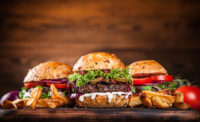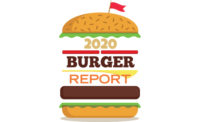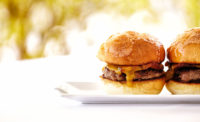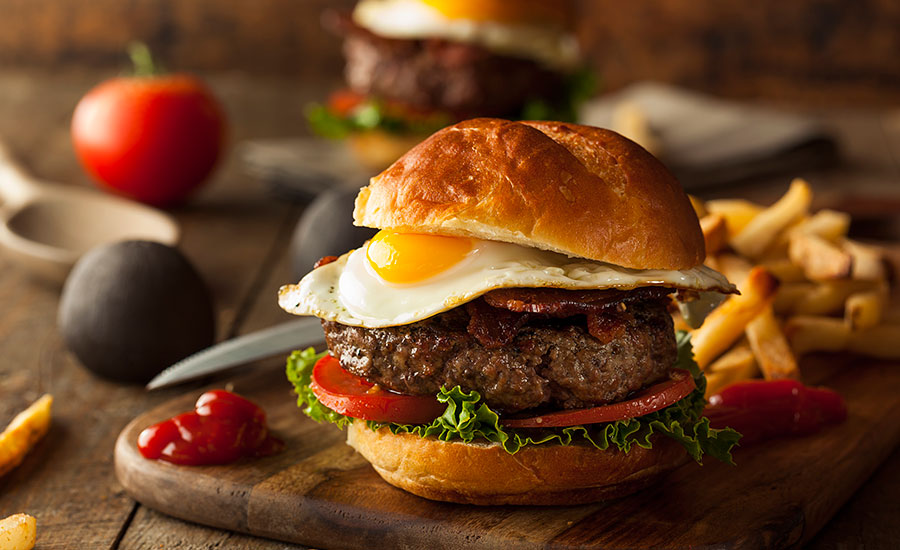The 2016 Burger Report: Packed with flavor
Burgers are the perfect platform to showcase exotic flavors, spicy jams and better ingredients.

About 75 percent of Americans eat a burger every week.

Adding protein toppers, such as pulled pork and fried eggs, provide another creative, flavorful topper for burgers.

Non-beef burgers, such as chicken and veggie burgers, are an emerging trend in the burger segment.

Sauces, toppings, and the bun are all being used as avenues to introduce new flavors to burgers.

Chicken burgers are the fastest growing burgers on menus in limited service restaurants while build-your-own burgers are fastest growing in full-service restaurants.

The majority of consumers think it's important for restaurants to offer topping and condiment customization.






An item as American as apple pie, the hamburger is also the perfect vehicle for introducing consumers to new trends, international flavors and formats.
“Consumers like burgers, because they can have what they know and experiment with trends and flavors,” says Jana Mann, senior director at MenuTrends, Datassential, based in Chicago.
If one wants a burger, they are not hard to find. More than 50 percent of all restaurants offer burgers, Mann says. And about 75 percent of Americans do eat a burger every week, she notes.
“More places are offering burgers than last year,” she says. “And the types of burgers being added are not basic, but cover several trends.”
Burger consumption is still slightly higher than pre-2010 levels, but has decreased slightly from when it was particularly elevated through 2011, 2012 and 2013, says Lizzy Freier, managing editor at Menu Analysis for Chicago-based Technomic.
“The recent decrease could be due in part to the negative health perceptions of beef — which tends to be the protein of choice for burger patties — and the increase in beef prices over the last couple of years due to the increased demand a few years ago,” says Freier.
Despite this change in consumption, the average consumer still eats a burger 5.3 times in a month, a higher average than for pizza — America’s other favorite food — which the average consumer eats 3.4 times a month, Freier says.
The typical burger eater is a man and younger consumer, Mann says.
“Burger occasions are overwhelmingly driven by cravings, but other purchase drivers include good value, portability and convenience,” Freier says.
Consumers also ask for variety and customization, which explains why build-your-own is such a big trend, she says.
“Consumers want to be in control of what goes into the food they eat,” says Casey Baker, consumer trend specialist for Cargill Value Added Meats, in Wichita, Kansas. “Customization is a way to allow these customers to call the shots when it comes to their burger cravings.”
Dining out
“Some of the strongest demand is seen in full-service and fast casual segments where burger prices are typically higher,” Baker says. “This shows that many regular burger consumers don’t view value or price as their primary purchase drivers.”
Indeed, QSR burger places remain the most visited segment for burgers with 74 percent of consumers reporting they got a QSR burger in the past three months, says Caleb Bryant, foodservice analyst at Mintel, based in Chicago.
It’s fair to say that the fast casual market is shaping the entire industry, says Bryant.
“These locations feature better burgers made with high-quality ingredients, forcing both QSRs and FSRs to elevate their burger program,” Bryant says. “Diners are responding to the premiumization of burgers as 55 percent of consumers agree they would be willing to pay more for burgers made with premium toppings.”
Creating a better burger
The quality of the meat used in the burger is an important attribute to consumers.
“This can mean different things to different people but some of the top initiatives happening at foodservice include hormone-free, free-range, grass-fed beef and transparency of ingredients and sourcing,” Freier says.
“Better burgers” are still going strong as consumers still value hamburgers with some sort of better-for-you claim, Baker says.
“That is a trend we’ve seen for several years and shows no sign of slowing down,” she says. “However, we’re now starting to see varied ways in which the consumer defines a ‘better burger.’”
For example, Baker notes one of the strongest trends lately is an increase in preference for specific high-quality beef cut patties such as sirloin or brisket to produce premium burgers.
“Consumers have also shown an increased focus on the ingredients of the burger beyond the patty such as specific buns and high-quality toppings,” Baker says. “So, we’re starting to see that health and quality continue to be a top priority for consumers, but there’s more than one way for operators to fulfill that need because quality is perceived in multiple ways.”
Looking at burgers from a larger industry-wide perspective, “natural” is set to be the most important buzz word for consumers in 2016, says Bryant, as 27 percent of consumers say they will be looking for natural ingredients more this year than last.
“Burgers can hop on this trend by using all natural ingredients, as well as making everything in house if possible,” says Bryant.
Showcasing exotic flavors
The entire foodservice landscape is diversifying as more internationally inspired restaurants open and more Americans adopt foodie lifestyles.
“We are also seeing burgers used as a platform to showcase international ingredients,” Bryant says. “Diners are generally hesitant to try unfamiliar ingredients like the Korean fermented cabbage dish kimchi; however, when you put kimchi on a burger, it suddenly becomes more familiar and thus more approachable for the general public.”
An example of a chain doing exactly this is Umami Burger with its K-BBQ Burger (topped with kimchi, sesame aioli and gochujang glaze). The Hard Rock Cafe launched its “International Burger Tour,” as well. This menu featured 20 internationally inspired burgers representing countries where Hard Rock Cafes are found, Bryant says.
“Burgers are a great way for chefs to get creative and experiment with non-traditional flavors, and consumers continue to seek out the newest concepts,” Baker says. “Spice and ethnic flavors continue to pop up on menus, but one of the newest developments is an increased presence of Asian-inspired burger builds.”
Spicy additions such as jalapenos, ghost peppers, chipotle, cayenne and habaneros, and spicy sauces such as buffalo and sriracha are also trending, Freier says.
“Despite increased [competition] from other cuisines, burgers remain a diner favorite with 62 percent of burger eaters self-identifying as ‘burger lovers,’” Bryant says. “There has been increased interest in international flavors in general, and burgers are a great platform to showcase new ingredients because burgers themselves are familiar.”
Building excitement
Sauces provide another avenue to introduce new flavors to burgers. “One in particular that is exploding is the use of savory jams,” Mann says. “So instead of using ketchup, the chef would put a honey or tomato jam on the burger. The customer is familiar with the spices and flavors, but the jam provides a more creative way to feature them.”
Alcohol is also showing up in burger sauces, glazes or veggies, Mann says. “Beer-battered or braised onions are popular,” she says. “Bourbon and whisky are trendy, so they can show up in sauces, as well.”
Spiked burgers are trickling down to fast food chains, as well. McDonald’s, for example, offered a Spirit of Kentucky Burger with Bourbon-Flavored Sauce for a limited time in Kentucky and parts of neighboring Indiana last year.
A few years ago, Hardee’s and Carl’s Jr. introduced a Jim Beam Bourbon Thickburger.
Proteins such as pulled pork, fried eggs, Reuben and brisket are also toppers.
“Adding protein gives another creative, flavorful topper for burgers,” Mann says.
They can also be mixed with different meat cuts to provide an interesting flavor. “Brisket, short ribs and ground beef are being mixed together,” Mann says.
The burger’s bun is also important when so many strong toppings are in play. “Pretzel buns mesh well with these new types of ingredients; brioche buns are popular. Waffles are also different and provide a sweet and savory combination,” Mann says.
One of the most interesting developments over the last year was the increase in burgers on breakfast menus.
“We’ve seen this trend pop up on menus of large and small restaurant chains; and although we’re not clear how each performed, it was an interesting change for the burger category as a whole,” says Baker. “It expanded the category to a new daypart and also opened up many new, creative build concepts.”
As Mann notes, more outlets are available for premium burgers as they appear on more menus and restaurant formats.
“Consumers are, of course, familiar with burgers, so restaurants can showcase their own take on burgers and trends and build excitement and business in the process,” Mann says. NP
Non-beef burgers on the rise
An emerging trend in the burger segment is the rise of non-beef burgers as consumers turn away from beef for health and expense reasons, says Caleb Bryant, a foodservice analyst at Mintel, based in Chicago.
“Overall beef consumption is down in the U.S., and more consumers are searching for alternative proteins,” Bryant says. “Turkey burgers or vegetarian burgers were once an afterthought on menus, something to appease just vegetarians or the health-conscious. Now we see chefs making non-beef burgers the star of the menu.”
He notes GQ magazine once ran the headline, “The Best Burger of the Year has No Meat in it.” Last year, Burger King launched a chicken burger nationwide, and McDonald’s has been testing chicken burgers in select markets.
Veggie burgers can be created with super foods such as chick peas, lentils and kale as substitutes for the traditional beef patty, says Jana Mann, senior director at MenuTrends, Datassential, based in Chicago.
“Data suggests they are on to something as 46 percent of burger eaters are interested in seeing chicken burgers on menus. Expect to see more restaurants place emphasis on non-beef burgers in the coming years,” Bryant says.
Looking for a reprint of this article?
From high-res PDFs to custom plaques, order your copy today!












